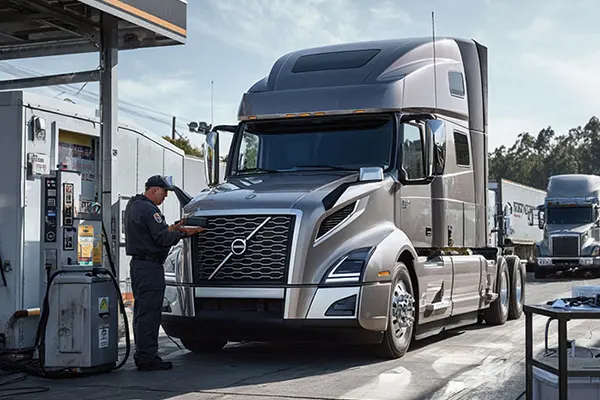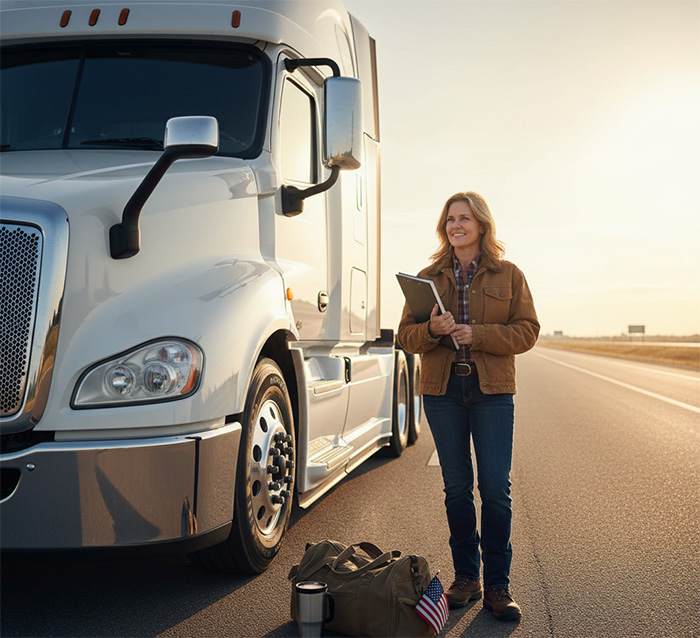
What Are the New Truck Emission Regulations in 2025?
New emission regulations for trucks in 2025 aim to drastically reduce NOx and CO₂ emissions by requiring advanced engine technologies and promoting zero-emission vehicles.
Federal vs. State-Level Regulations
In 2025, both federal and state governments are tightening emission standards for commercial vehicles. The Environmental Protection Agency (EPA) is rolling out its Clean Trucks Plan, which sets stricter standards for nitrogen oxides (NOx) and greenhouse gases (GHGs) emitted by heavy-duty trucks. These regulations focus on cleaner engines, more efficient fuel usage, and the gradual shift toward electric and hydrogen-powered alternatives.
Meanwhile, California’s Air Resources Board (CARB) has enacted even more aggressive measures through its Advanced Clean Trucks (ACT) and Advanced Clean Fleets (ACF) regulations. These rules not only limit tailpipe emissions but also mandate that a certain percentage of fleet purchases be zero-emission vehicles (ZEVs) starting in 2025.
Key Difference:
The EPA sets a national baseline, but states like California (and others that adopt CARB rules) can impose stricter emission limits, especially for diesel-powered vehicles.
Timeline and Rollout
The implementation of these regulations follows a phased approach:
- January 2025: New heavy-duty vehicles must meet updated NOx and CO₂ emission standards under the EPA rule.
- 2025–2030: Gradual increase in zero-emission truck sales required in CARB-compliant states.
- 2027: Second phase of EPA GHG standards begins, with tighter limits and enforcement for vehicle manufacturers.
- 2035 Goal (CARB): All new medium- and heavy-duty trucks sold in California must be zero-emission.
Trucking companies and independent operators are expected to either retrofit older vehicles or invest in compliant new models to stay operational.
Vehicle Types Affected
The regulations impact a broad range of vehicles, including:
- Heavy-Duty Long-Haul Trucks: These face the most significant changes due to high emissions over long distances.
- Local Delivery Trucks (Class 3–6): Must transition toward cleaner engines or zero-emission technology, especially in urban zones.
- Vocational Trucks: Dump trucks, garbage trucks, and utility vehicles will be required to meet both idle and operation-phase emission caps.
Note: Exemptions may apply for vintage trucks, specialty equipment, or low-mileage vehicles under certain conditions, but these are limited and subject to approval.
Why Truck Drivers Should Care
New emission regulations don’t just affect manufacturers and fleet owners ¾ they have direct and immediate consequences for truck drivers, especially those operating independently or managing small fleets.
Job Implications: Compliance Enforcement and Penalties
Truck drivers are now on the front lines of compliance enforcement. If a vehicle doesn’t meet new emission standards, drivers may be pulled from service, denied entry into certain states (like California), or be subjected to roadside citations. In many states, emission compliance is becoming a requirement for renewing CDL-linked operating permits and accessing weigh stations without delay.
Quick Fact: States like California and New York are already using roadside sensors and mobile enforcement teams to spot high-emission vehicles in real time.
Financial Costs of Non-Compliance
Failing to comply with new regulations can lead to serious financial setbacks:
- Fines: Up to $25,000 per violation in some jurisdictions.
- Delayed Permits: Non-compliant trucks can experience licensing or registration delays.
- Operational Disruptions: Being grounded for inspection or repairs means lost revenue.
For independent drivers, an unexpected fine or a week of downtime can be financially devastating. Retrofitting an older diesel truck may cost $15,000–$30,000, while a new zero-emission vehicle could exceed $120,000.
Stricter Inspections and Roadside Enforcement
Regulatory agencies are increasing both the frequency and intensity of inspections:
- Mobile Inspection Units: These are now equipped with emissions scanners.
- Port-of-Entry Checkpoints: CARB-compliant states require documented proof of compliance.
- Real-Time Reporting Tools: Trucks with outdated or missing emission control equipment can now be easily flagged.
Drivers are advised to keep digital or printed verification of their truck’s emission status at all times.
How the Rules Affect Owner-Operators and Small Fleets
While large logistics companies often have the resources to adapt quickly, owner-operators and small fleet owners face unique challenges under the new 2025 emission regulations. Compliance can mean the difference between staying in business and being sidelined.
Impact on Owner-Operators
For independent drivers who own their rigs, the new regulations bring significant financial and logistical hurdles:
- Upgrade Pressure: Many older diesel engines no longer meet federal or CARB standards, forcing drivers to either retrofit their vehicles or purchase newer, compliant models.
- Limited Options: Electric trucks are often too expensive for single operators, and lease terms can be restrictive or unavailable in certain regions.
- Resale Value Drop: Non-compliant diesel trucks are rapidly losing value, making trade-ins or private sales less viable.
Cost Snapshot:
A retrofit for a Class 8 diesel truck can cost between $15,000–$30,000, while purchasing a new electric semi may exceed $120,000–$150,000 depending on brand and configuration.
Challenges Facing Small Fleets
Small fleets (2–20 trucks) are caught in a difficult position ¾ they’re large enough to be regulated, but often too small to secure volume discounts or financing for electric truck purchases.
Key issues include:
- Cash Flow Strain: Upfront costs for fleet upgrades or replacements can eat into operating margins.
- Regulatory Complexity: Multi-state operators must navigate varying emissions laws, which may require separate compliance strategies for different jurisdictions.
- Insurance and Warranty Gaps: New low-emission or zero-emission vehicles sometimes fall outside traditional insurance policies or maintenance plans.
Example: A small Midwest-based fleet reported that upgrading just 4 trucks to EPA-compliant engines cost over $180,000 ¾ without including downtime or training.
Are There Any Benefits?
Yes ¾ early adopters of compliant technologies may unlock real advantages:
- Tax Credits and Incentives: Federal and state-level grants may offset a portion of costs (e.g., the EPA’s Clean Heavy-Duty Vehicle Program).
- Access to New Contracts: Many shippers and retailers now require clean fleets for high-value loads.
- Fuel and Maintenance Savings: Zero-emission vehicles often cost less to maintain and operate over time, despite higher purchase prices.
Quick Tip:
California’s HVIP (Hybrid and Zero-Emission Truck and Bus Voucher Incentive Project) offers up to $120,000 per eligible vehicle, but funding is first-come, first-served.
In short, while the upfront costs and logistics can be daunting, small operators who adapt early may gain a competitive edge, especially as regulations tighten and demand for clean logistics increases.
What Are the Alternatives to Diesel?
With traditional diesel engines facing strict emissions limits, many truck drivers and fleet owners are exploring cleaner, more sustainable fuel options. The good news? Several viable alternatives to diesel are emerging, each with unique benefits and trade-offs.
1. Electric Trucks
Electric semi-trucks are gaining ground quickly, especially for short- to medium-haul routes.
Pros:
- Zero tailpipe emissions
- Lower maintenance costs (no oil changes, fewer moving parts)
- Qualify for state and federal incentives
Cons:
- High upfront cost
- Limited range (typically 150–300 miles)
- Charging infrastructure still under development in many areas
Best Use: Local delivery and regional haul routes.
2. Hydrogen Fuel Cell Trucks
Hydrogen trucks convert compressed hydrogen gas into electricity, emitting only water vapor.
Pros:
- Fast refueling times (similar to diesel)
- Longer range than battery-electric vehicles (up to 600 miles)
- Ideal for long-haul applications
Cons:
- Very limited refueling infrastructure
- High vehicle and hydrogen production costs
- Technology still maturing
Best Use: Long-distance freight corridors with hydrogen stations.
3. Renewable Natural Gas (RNG) Vehicles
RNG-powered trucks burn methane captured from landfills and agricultural waste.
Pros:
- Lower emissions than diesel
- Familiar engine tech for maintenance teams
- Some infrastructure already in place
Cons:
- Still emits some greenhouse gases
- RNG availability varies by region
- May not qualify as a zero-emission solution in all jurisdictions.
Best Use: Fleets operating in RNG-supported metro areas.
Side-by-Side Comparison Table
Infrastructure Considerations
Infrastructure is a major factor in choosing a diesel alternative. While electric charging stations are expanding through federal funding ¾ especially along major freight corridors ¾ hydrogen refueling stations remain scarce outside of California. RNG stations are more common in certain metro regions, but access is still not nationwide.
Pro Tip: Use tools like the U.S. DOE’s Alternative Fueling Station Locator to plan routes and assess feasibility.
As the market matures, the cost and performance gaps between these technologies and diesel will continue to shrink. But for now, the best alternative depends on your route type, refueling access, and budget.
Compliance Checklist for Truck Drivers
Navigating the 2025 emission regulations doesn’t have to be overwhelming. A clear compliance checklist can help truck drivers stay legal, avoid fines, and minimize downtime.
How to Stay Compliant with New Emission Laws:
Step-by-Step Guide:
- Check your truck’s emissions rating
- Review EPA or CARB compliance rules
- Schedule a retrofit or upgrade, if needed
- Register for state or local clean fleet programs
- Keep compliance documents in the cab
1. Check Your Truck’s Emission Status
Start by identifying your vehicle’s engine model year and emissions classification. You can usually find this on the engine control label or VIN report.
Before moving onto the next step, be sure you can answer the following questions:
- Does your truck meet 2025 EPA standards?
- If operating in California, does it pass CARB requirements?
Use online lookup tools like the EPA’s Vehicle Emissions Compliance Portal or state DMV systems.
2. Understand the Rules That Apply to Your Route
If you cross state lines, you may be subject to both federal and state-specific emissions laws.
- CARB states (e.g., California, Oregon, New Jersey) have stricter regulations.
- Non-CARB states follow EPA minimums but may still enforce inspections.
Be especially cautious when hauling into port cities, metro zones, or regulated environmental corridors.
3. Retrofit or Upgrade as Needed
If your truck doesn’t meet emissions standards:
- Retrofit: Add a diesel particulate filter (DPF), NOx reduction system, or idle-reduction tech.
- Replace: Invest in a new or used emissions-compliant vehicle.
- Lease: Many compliant electric or low-NOx trucks are now available for lease with fleet incentives.
Funding Tip: Look into state vouchers, clean vehicle grants, or federal tax credits to offset upgrade costs.
4. Register with Clean Fleet or Emission Reporting Programs
Some states require formal registration in programs like:
- CARB’s Clean Truck Check
- New York’s Diesel Emissions Reduction Act registry
- Voluntary Clean Freight programs (EPA SmartWay)
These registrations often require VINs, emissions system documentation, and regular reporting.
5. Keep Paperwork Handy at All Times
Always carry:
- Proof of compliance or exemption
- Engine emissions certification label
- Retrofit receipts or upgrade invoices
- Registration confirmation for relevant programs
Pro Tip: Keep digital versions on your ELD or cloud storage for fast roadside access.
Following these steps ensures you’re covered in the event of an inspection and allows you to keep hauling without unnecessary delays or costly penalties.
FAQs
Q1: Do I have to replace my diesel truck in 2025?
No, not necessarily. If your truck meets updated EPA or CARB standards, you can continue operating. Retrofitting may also be an option for older engines depending on age and condition.
Will electric trucks work for long-haul routes?
Not effectively ¾ yet. Most electric trucks currently have a limited range of 150–300 miles. Long-haul applications are still better suited for diesel or hydrogen, though technology is rapidly improving.
Can small operators afford to comply?
Yes, with careful planning. Many states offer grants, tax credits, and low-interest loans. The key is applying early and knowing what programs you’re eligible for.
Are emission laws the same in every state?
No. States like California, New York, and Oregon follow stricter CARB standards, while others follow only federal EPA guidelines. Always check local requirements if you cross state lines.
Please fill out the information below and our team will reach out to chat about your options.


